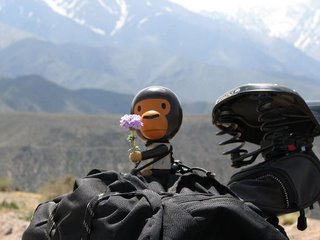Uspallata to San Carlos
 Milo enjoying the Argentine spring.
Milo enjoying the Argentine spring.The rivers are full of snow melt and the altiplano meadows are covered in these purple flowers.
We picked him the flower to cheer him up as he'd just lost his helmet on the way up the hill.
 Wild horses on the altiplano.
Wild horses on the altiplano. Looking back towards Uspallata near Cerro Tupungato, another huge peak over 6600m.
Looking back towards Uspallata near Cerro Tupungato, another huge peak over 6600m. Northern Argentina has many of these shrines to the 'Difunta Correa'. Passing drivers stop and leave bottles of water, which I suppose we could filter in an emergency.
Northern Argentina has many of these shrines to the 'Difunta Correa'. Passing drivers stop and leave bottles of water, which I suppose we could filter in an emergency.According to legend, María Antonia Deolinda Correa died of thirst in the desert while following her conscript husband—a small land-owner—during the mid-19th-century civil wars. When passing muleteers found her body, her baby son was still alive, feeding at her breast. While it seems far-fetched that any infant could survive on milk from a lifeless body, the legend had such resonance among local folk that the waterless site became a spontaneous shrine. The Difunta (“Defunct,” as dead people are known in the countryside) became a popular “saint,” despite limited proof that she even existed.
